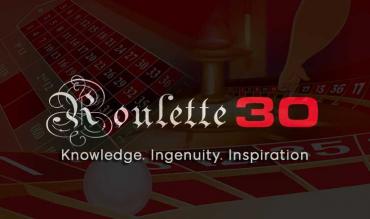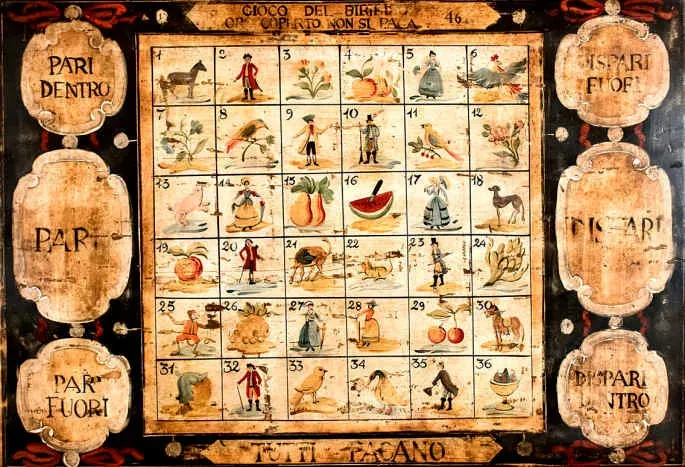The history of roulette is full of surprising twists and intrigues. In this article we will start from the origin of the games which have preceded the birth of the casinos and we will travel through the centuries during which Europe and the whole world have radically changed. Though gambling – gambling never changes.
The roulette and the casino have contributed to the changing of history, by making or – most of the times- by destroying the lives and fortunes of famous people, causing bankruptcy, and even death.
Casinos have accumulated money making little towns flourish and prosper or at the same time financing countries, which –by using this money- were able to do good (by reducing taxes for their citizens) or do bad (by financing war campaigns).
The world changes, but the roulette doesn’t and even today with the new technology and the online games the result has been the same for the last three centuries. The houses of games make money, and govern those who collect the taxes. On the other hand there are the players who try the emotions of the game and contribute to keeping the roulette turning.
Roulette ancestor games
1765 – The first gambling clubs
1796 – The first official description of roulette
1810 – Roulette disembarks in the United States
1838 – Roulette lands in the German spa resorts
1840 – The birth of Roulettenburg
1855 – Société des Bains de Mer
1863 – Francois Blanc at the Monte Carlo
1872 – German casinos closing down
1891 – The Monte Carlo myth
1941 – First casino in Las Vegas
The games which have influenced the birth of roulette
The roulette was born from the union of various games played in the past which were known in the 17th century. It is said that its origin goes back to the times when the Roman soldiers gambled by making a shield with special signs turn on a spear. The same criterion was used in the Middle Ages, by using the wheel of a cart.
The games which have mostly influenced the development of the roulette are the “hoca” the “biribisso” and the game of “Even – Odd”.
The hoca was made by a six beam wheel attached to a central pivot on which a little ball rested. The wheel was turned and the ball fell to the side into one of 42 boxes. The dealer/bank had three to six boxes reserved for him. Given that the game was very favorable for the dealer/bank it seems that Louis XIV contributed to its spread in order to increase his own fortune.
The Biribisso was popular in Italy between 1600 and 1700 and was a kind of bingo game consisting of perforated balls which contained a ticket with a number on and a rug on which the players placed their money and were paid when the winning number came out or by red, black, odd, even, high or low. It was abolished in Italy at the end of 1700 and took off in France under the name “biribi”. It was played in two versions, the classic one with 70 numbers (paid 63 to 1) and the “street” version with only 36 numbers and smaller chances. It was drawn on a sheet which was easier to hide when the police arrived.
The game Even-Odd consisted of a cylinder containing 40 boxes with the letters E (Even) and O (Odd) alternating, two of which were in favour of the bank. Players could only bet on Even or Odd and were paid accordingly. By combining the mechanism of the spinning wheel the combinations that paid money, the numbers 1-36 and the rug of the street version of Biribi the modern Roulette was created (Roulette = little wheel in French).
1765 The birth of the gambling halls
Gambling was a widespread phenomenon among the Parisian bourgeoisie under the reign of Henry V. Private clubs where illegal gambling was possible were many and it was impossible to prevent con artists and cheaters from fixing the games and robbing the players.
When the phenomenon took on alarming proportions the head of the Paris Police at the time, Gabriel de Sartine, Count of Alby decided to legalize gambling in order to control the situation by giving permission only to certain games and only to some special rooms which would operate under the supervision of the police.
By doing this he could arrest all those who played in other places , guarantee protection to the rich and the aristocrats who would otherwise be victims of scams and robberies and in addition the Finance Ministry would profit from the advantage of the bank.
The venue chosen for the first official casino was the Palais Royal in Paris.
This way, along with the other popular card games of the time, the roulette makes its appearance, exactly as we know it today. With the alternating red and black numbers, the zero and the double zero. The only difference with today’s roulette is that the zero is red and the double zero black. But the colours are not paid with the release of these combinations.
Not only the roulette but also the management of the gambling hall is reorganized and so the rules and the figures of the croupier and the inspectors are born the way we know them today. The roulette and the casino become an instant success both for the players and the managers.
1796 The first official description of roulette
The first official description of the game was made by the French writer Jacques Lablee in his book “Roulette, or the history of a player” (1802) which describes the adventures of a boy who becomes a gambler in the Paris of 1796.
The book accurately describes both the roulette table, with its three vertical columns of 12 numbers each and the spaces for simple bets on red, black, manque, passe even or odd, exactly as we find it today.
The book is written as a collection of letters by the player to his wife in which he describes both the places and the people’s emotions. It makes a very vivid reading because it shows that the player’s mind was preoccupied by the same thoughts and the same concerns as today’s players.
Below we can see the pages in which the roulette and some game strategies are described.
1810 Roulette disembarks in the United States
The first game halls are born in the French colonies of the United States and the city of New Orleans becomes their capital. The swarming of players from each race and social class inevitably brings discussions, broils, homicides and suicides and for these reasons it is decided to move legal gambling to the river boats on Mississipi.
During the same period the gold rush to California results in the building of new Casinos and the moving of gambling to the frontier towns. The roulette wheels were the same as the ones used in France, although for a brief period of time in some casinos appeared wheels and tables with an additional small box depicting the symbol of the American eagle (the box obviously being in favor of the bank).
1838 Roulette lands in the German spa resorts
At the beginning of the 1800’s the most famous spa resorts introduce the new types of gambling halls to entertain regular customers and attract new ones.
Napoleon, opposed to gambling, decides not to close the casinos but to limit their number; after all the revenues coming from them helped him finance his campaigns. Only a dozen of them stay open in France, five in Paris and the rest in the most famous spa resorts, like Aix les Bains.
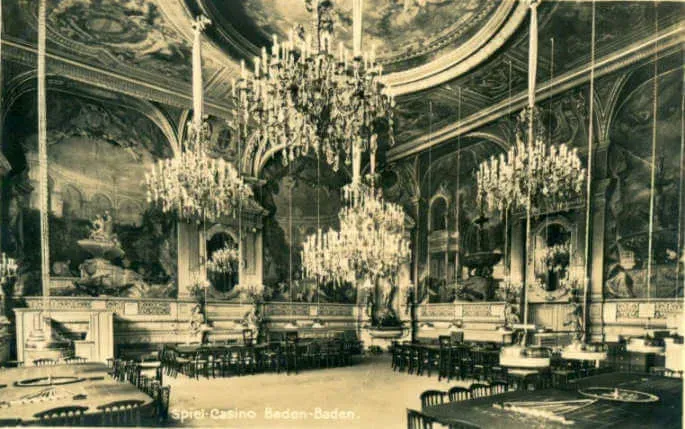
|
| Casino Baden Baden, 19th century |
At the same time, in the neighboring Germany the spa resorts open their own casinos, with the beginning made at Baden Baden (in 1808) one of the oldest and most famous European resorts known from the times of the Roman emperor Caracalla. The roulette attracts important clients and therefore assets and well-being and those small towns become elegant holiday places for the aristocracy and the bourgeoisie of the whole Europe.
In the area of the Rhine there is a hive of “Bad” and both in the old and the new centres of thermal treatment the casino becomes the main attraction, contributing to the diffusion of the popularity of the roulette.
With the accession to the throne of King Louis Philippe of the Orleans, who was opposed to gambling the destiny of the French gambling halls seems determined and indeed they are officially abolished in the 1 January 1938. It is the beginning of a prosperity period for the German casinos.
1840 The birth of Roulettenburg
The brothers Francois and Louis Blanc are granted the gambling hall of the spa resort of Bad Homburg near Frankfurt. They convince Count Philip to approve the construction of the new casino and the expansion of the spa facilities which will be celebrated in 1843 with a grand opening party.
The Blanc brothers launch a massive advertising campaign in the magazines of the time by buying advertising pages and by offering free stay to grateful journalists. They exalt the benefits of the cure and wink an eye to the French players who are left without a casino in their own country. In the records of the casino, we can find illustrious names of historical personalities of the times and it is likely that Fedor Dostojevsky was inspired to describe the city of Roulettenburg in which Alexej Ivanovic, the main character in “The Gambler” experiences joy and disgrace.
The advertising campaign attracted a variety of players, but Francois Blanc’s objective was to make his casino the first and the best and for that reason he felt he had to attract customers from the oldest and most famous German areas such as Baden Baden, Wiesbaden and Elms. His ingenious idea was to make the roulette game more advantageous for the players by eliminating a zero, decreasing thus the percentage in favor of the bank. Similar changes were made for the 30/40 card game favorite among roulette players and very fashionable at the time for its big payouts achievable with consecutive series of combinations.
The objective of the Blancs was to attract important players who knew the game well and held large funds. They would certainly make less profit but the choice to focus on quality rather than quantity, as the story has shown us, was the winning choice that made a fortune for Bad Homburg, the Blancs and all the members of the casino.
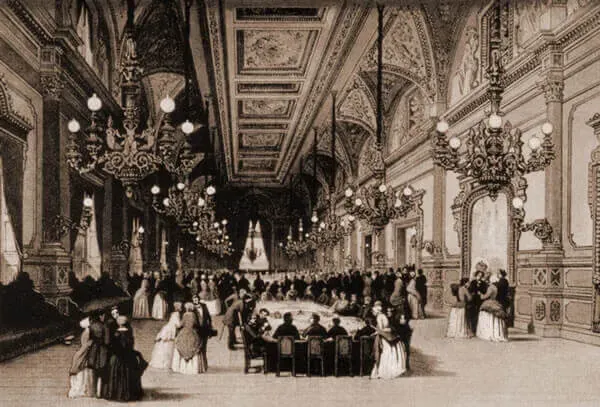
|
| Bad Homburg Casino gaming hall. Players around an enormous roulette table. |
1855 Société des Bains de Mer
At the time, the Principality of Monaco was facing difficulties. Menton and Roquebrune were detached from the Principality and as a result the Ranieris were unable to profit from 4/5 of a territory rich in olive trees and farmlands.
Having seen the success of the German strategy of attracting the tourists with the spa treatments and the additional income from the casinos and by counting on the possibility of the Principality to compete by offering a mild climate throughout the whole year the Ranieris authorized the opening of a spa center with a casino in the hope of revitalizing the economy and making Monaco and the Monegasque royal family prosper with the induced flow of tourists.
Therefore, the birth of the Société des Bains de Mer took place and Prince Rainier accepted the proposal of two French entrepreneurs, Langlois and Aubert to undertake the immediate opening of a casino in Villa Bellevue.
Unfortunately, due to the lack of adequate means of connection to reach the principality and the reluctance of managers to invest and risk their capitals, they did not make it off the ground. The two businessmen expected to expand and develop the casino by using the money collected by the players but in order to do so they needed the players.
It is said that days passed by without seeing one and that among those few who presented themselves there were crooks with counterfeit coins. Langlois and Aubert failed and had to sell their shares to a new owner, Pierre August Daval.
1863 Francois Blanc assumes control of the Monte Carlo casino
After three negative experiences prince Carlo III decides to entrust the management of the Society to Francois Blanc who signed the concession for 50 years.
The bare rock of Speluges (rich in caves) had already been given by the prince for the construction of casinos and hotels but the predecessors had never found the capital to invest. Blanc immediately accelerated the construction of the casino, the grand hotel and the theater. He increased the number of boats coming to and from Nice and Menton and applied political pressure to release the project for the coastal railway.
On the front of the game, he immediately eliminated the second zero which Lefevre short of money had reestablished and doubled the cash reserves of the casino, raising the maximum bets. On completion of the casino, the big rock was renamed as Monte Carlo, in honor of the Prince.
1872 The closing of the German casinos
The chancellor of the new empire, Otto von Bismark had never been favorable towards casinos and with the Franco-Prussian war of 1870 was even more negative towards the casinos run by French.
The new government passed a law signed by Bismark himself stating that by the end of 1872 all casinos in the Prussian territory would have to close. It was one decision categorical that would impoverish and reduce the life expectancy of many citizens who used to benefit from the industry. Guided by Blanc himself they tried to appeal to the Chancellor, but in vain.
On November 30 1871, Bismark’s son went to Homburg, played and won 18,000 francs. Observers at the time claim that that was also one of the reasons why the Chancellor was so adamant in his decision. The Chronicles of Hamburg casino narrate that in the final days there was an extremely increased number of players from the whole Europe competing for the last strokes of luck. At exactly five to eleven the croupier announced: “Gentlemen, for the last time…. forever!” never has the world seen a table so full of betting. For the history, the last number that came out was 20 black.
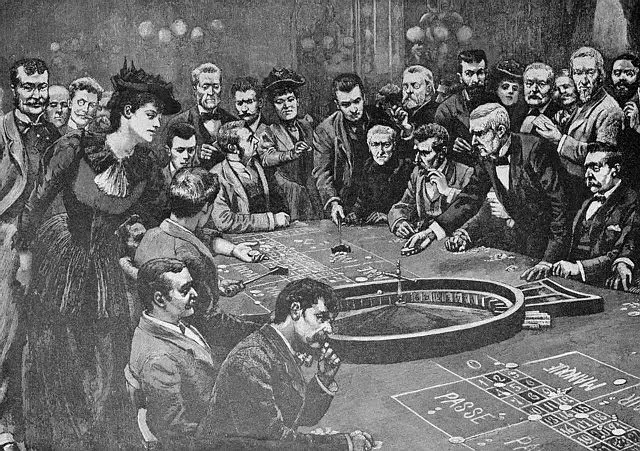
|
| Americans playing roulette at Monte Carlo in 1892 |
1891 The birth of the Monte Carlo myth
With the French casinos closed for years and the closing of the German casinos, Monte Carlo didn’t have any more competitors, with the exception of some small casinos in Switzerland with local and habitual clientele.
The Principality commenced a deep urban transformation with the building of luxurious hotels other small gaming rooms and the casino itself undergoes an architectonic transformation to become even more elegant and welcoming.
The final push to the development and progress of Monte Carlo came in 1891, when the issue of gambling in the principality of Monaco was submitted for the last time in the French Parliament. It was proclaimed that “the principality of Monaco is completely independent and its independence is recognized”.
Monaco holds the monopoly for many years, attracting the international jet set and the reopening of casinos in Europe in the 20th century does not damage the myth. The roulette of the casino of Montecarlo remains as a symbol of the roulette of the world.
1941 The first casino in Las Vegas
The small town of Las Vegas in the Nevada Desert was just a small town for passers-by on Highway 91 which led from California to Salt lake City, Utah. With the beginning of the work on the colossal Hoover Dam its history changes. For five years the place had to accommodate thousands of workers and its identity changed. Gambling was legalized in that year and entertainment venues were created throughout the city which offered not only pleasures of the flesh but also the chance to play.
The first real casino was the “El Rancho Las Vegas” which was inaugurated in 1941 on the side of Highway 91. It then became “Las Vegas Boulevard” and is now known worldwide by the nickname “The Strip”. It seems that the owner Tom Hull decided to build a hotel in 1938 when he was stranded at the entrance of the town under the hot sun, because his car dad broken down. He bought a lot at that spot, built the hotel and added the casino. His example was followed by other entrepreneurs and not before long many of the casinos whose names are part of the history of the city were born.
- Last Frontier (1942)
- Flamingo (1947)
- Sahara (1947)
- Thunderbird (1948)
- Desert Inn (1950)
- Sands (1952)
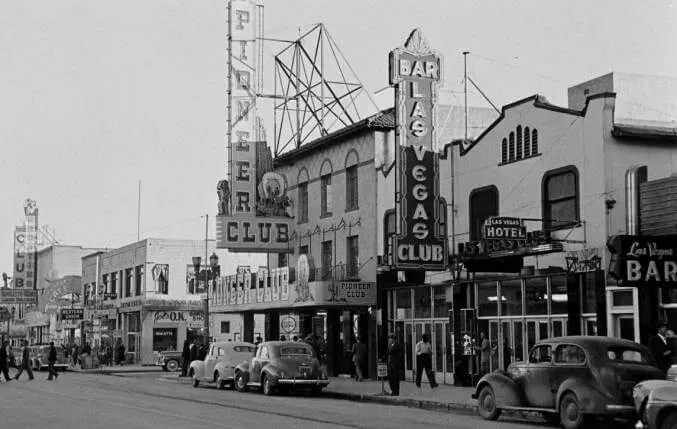
|
| Las Vegas in 1940’s |
